By Chantal Guillou-Brennan, Contributing Editor, JAXFAX Travel Marketing Magazine
Article published in 2 parts in the December 2004 issue, and February issue 2005
Guatemala is a land of rich and diverse cultural heritage, architectural wonders and friendly people who welcome you with brilliant smiles. The official language is Spanish, however Guatemala officially recognized 23 of the 40+ Amerindian languages; and as I was reminded, with fervor, by a young boy of Mayan descent on the shore of Lake Atitlan: "the Mayan are not history," they are here today and with 40% of the population of Mayan ancestry their culture is alive. Alive in the arts, the religion which is basically a brand of Catholicism tinted with Mayan shamanism or as in Chichicastenango or Santiago on the shore of Lake Atitlan more a blend of Mayan religious practice with a Catholic flavor. The Spanish colonists often destroyed the existing Mayan temples to use the material and build Catholic churches on top of the original Mayan foundations. So, today it is not uncommon to witness a ceremony on the outside steps of a church-remains of a Mayan temple! Yet the Mayan culture and the Spanish colonial heritage live side by side often finding rich expressions in the arts and religious rites.
Peten in the eastern part of the counry is home of the spectacular Mayan city of Tikal where worshippers still gather in its main plaza.
Guatemala City
With its International Airport, "La Aurora" Guatemala City is a good starting point to visit the rest of the country. Give yourself a day or two to enjoy the largest, most modern and cosmopolitan city in Central America. With two million inhabitants, Guatemala City is fast paced and vibrant, Guate, as it’s referred to locally, is a wonderful blend of old and new. The colorfully decorated, former U.S. school buses are used for public transportation and add to the city's Latin charm. Visitors interested in handicrafts will find them in the Central Market, located a block away from the Cathedral. The capital city is divided in zones with museums mostly in Zone 10, such as the Popol Vuh named after a famous and legendary book (the Mayan Bible) it exhibits a superb private collection of Mayan and Spanish colonial art, (strangely enough a similar account of the Tower of Babel is related in the Popol Vuh!) and the Museo Ixchel del Troje Indígena, which displays the rich traditional arts and costumes of Guatemala's highland towns.
A bus route runs from any of the luxury hotels in Zone 10 such as the Quinta Real, or the Inter-Continental and Hotel Viva Clarion Suites through the historic district stopping at the imposing Nacional Place of Culture (must be visited on foot since it is a pedestrian area), the twin-towered Metropolitan Cathedral—built between 1782 and 1815—has magnificent religious icons and paintings, and La Merced Church of neoclassic style also houses a rich collection of altar pieces and paintings moved from La Merced church in Antigua after the 1770 earthquake.
Lining the wide divider of the Avenidad des Americanas is a series of memorials in honor of many foreign countries which lead to the Berlin Park: a quiet resting place for the two large blocks of the former Berlin wall now adorned with contemporary graffiti screaming peace and love. This vantage point offers a great view of the city below as well as the surrounding volcanoes scratching the hazy sky.
Where to stay in Guatemala City
In what is called the “Zona Viva” only minutes from the international airport, several luxury hotels offer all the amenities and guest services expected from grand class hotels including restaurants, bar, business center with internet connection and meeting facilities, massage therapy, gym, and swimming pool.
The Hotel Viva Clarion Suites offers 172 comfortable suites with panoramic views of the city as well as one Presidential Suite and two Master Suites with the usual amenities plus access to a golf course. Price starts at $20 per person in quadrupal. Visit: www.hotelclarionguatemala.com, tel. 800-252-7466.
The luxurious Hotel Real Inter-Continental Guatemala offers 176 deluxe rooms perfectly equipped plus one Presidential Suite, six Junior Suites, 23 Business rooms, and 31 Inter-Continental Club Rooms. Dining options include the Cafè de la Paix, the St. Honoré Boulangerie Patisserie and the Scenario bar. Visit: www.intercontinental.com.
Five minutes from the Viva Zona, the Hotel Quinta Real Guatemala offers its guest excellent comfort and taste, with 123 exclusive suites charmingly decorated with local art and a Mauresque architectural flare surrounded by beautiful inner gardens with waterfalls and tropical flowers. The restaurant—Las Ventanas, offers a magnificent view of the volcanoes that surround the city. Rates range from $179 for a Grand Class suite to $1,000 (high season) for the beautiful Presidential suite. Visit: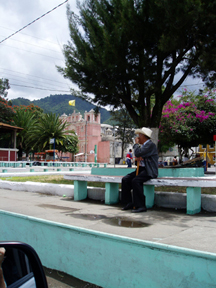 www.quintareal.com or email: reservaciones@quintareal.com.
www.quintareal.com or email: reservaciones@quintareal.com.
Antigua
From Guatemala city a mere 45 minutes drive away is Antigua, one of the world's best conserved colonial cities in Guatemala.
This captivating small town has a large English-speaking community, a wide range of accommodations and a bustling nightlife as well as a fantastic array of art galleries, exhibits and museums. In 1979 UNESCO recognized Antigua as a Cultural Heritage of Mankind site.
Strolling along the town’s cobblestone streets, the underground utilities accentuate the feeling of timelessness broken here and there by Coca Cola logos on the street candelabras! The company donated funds for this purpose but unfortunately the city ran out of money to finish the job. Will Pepsi come to the rescue?
Nestled between three dramatic volcanoes: Agua, Fuego and Acatenango, Antigua was at one time home to more than 30 monastic orders who built stunning monasteries, convents and cathedrals in and around the town.
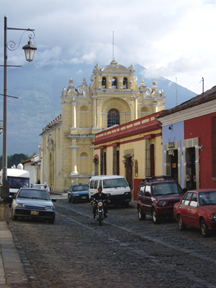 Many of the city's churches have lost much of their Baroque splendor, forgotten with the post-earthquake repairs and restorations, yet many remain impressive in particular La Merced, Iglesia de San Francisco and Las Capuchinas (now a museum). Casa K'ojom (kojom.org) is also a fascinating museum of Mayan music and ceremonies and related artifacts. As interesting as it is unusual the Museum Collection 2000 houses over 400 pre- to post-Columbia Mayan art pieces presented side by side with contemporary glass and crystal sculptures, masks and other compositions created by renowned international artists such as Bjorn Ekegren (Sweden), Shan Athari (U.S.), Susan Point (France) and Danielle Foudière (Canada.) On Sundays, locals gather at the busy market held in Parque Central.
Many of the city's churches have lost much of their Baroque splendor, forgotten with the post-earthquake repairs and restorations, yet many remain impressive in particular La Merced, Iglesia de San Francisco and Las Capuchinas (now a museum). Casa K'ojom (kojom.org) is also a fascinating museum of Mayan music and ceremonies and related artifacts. As interesting as it is unusual the Museum Collection 2000 houses over 400 pre- to post-Columbia Mayan art pieces presented side by side with contemporary glass and crystal sculptures, masks and other compositions created by renowned international artists such as Bjorn Ekegren (Sweden), Shan Athari (U.S.), Susan Point (France) and Danielle Foudière (Canada.) On Sundays, locals gather at the busy market held in Parque Central.
Among the best preserved colonial architecture is Las Capuchinas, the Capuchin Convent, completed in 1736 under the direction of the chief architect of the city, Diego de Porres. Today the convent is partially intact and partially in ruins. The intact portions house a museum and offices for the National Council for the Protection of Antigua Guatemala. The ruined sections include baths for the nuns, and an unusual circular area containing novices cells, each complete with its own sewer system. Below this circular patio is a mysterious, subterranean chamber that resonates wonderfully to the smallest sound. One can only imagine what the growing “Aum” would be like that was created by the repetitious mumbling of prayers as the nuns walked endlessly around the massive pillar holding the large cupola. The ruined nave of the chapel, approximately 120 feet long, can be viewed from the nuns' choir loft, accessed from the second floor level of the ruins. From the second floor a great view can be had of the twin volcanoes Fuego and Acatenango. Looking across the ruins, one sees the towers of La Merced Church. The façade of La Merced is one of the most beautiful in Antigua, featuring intricate and ornate patterns in white stucco on a yellow background. Although somewhat damaged in 1773, the church was repaired and remains in service today, but the original religious icons and fine furnishings were removed to the new Mercedarian church in Guatemala City where the order moved. La Merced remains the starting and ending point for the famous Good Friday procession in Antigua.
There are so many fascinating art galleries and museums in Antigua that you could spend days hopping from one to the other. The Jade Museum, Factory and jewelery store is definitely worth the stop; and no need to be alarmed by the armed guard at the entrances!
For a nice nature walk I suggest the Capeuleu Coffee Plantation in Alotenango—a short drive from Antigua. The plantation is open for touring year-round and consumption of outstanding 100% organic beans is also available. Capeuleu Coffee can be purchased in the Aurora airport or at the plantation.
Where to stay in Antigua
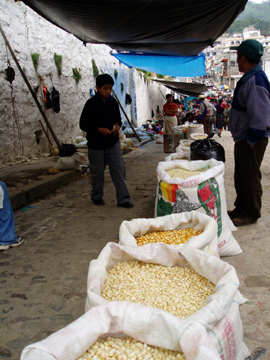 Many colonial homes with rooms arranged around a central patio have been converted into hotels, art or shopping galleries.
Many colonial homes with rooms arranged around a central patio have been converted into hotels, art or shopping galleries.
The Casa Santo Domingo, a five-star luxury hotel is no exception. Built around three centuries of history, art and mysticism the hotel and restaurant, which has its own pool and jacuzzi, is also a cultural center with a Colonial Art Museum and a Handicraft Museum. Rates for one of the 107 rooms range from $95 (low season, standard) to $193 (high season, deluxe) Visit: www.casasantodomingo.com.gt, or email: domingo@terra.com.gt.
An authentic 270-year-old property, the Hotel Posada de don Rodrigo, has also been renovated to serve as a first class hotel while preserving some original colonial furnishings such as the heavy wooden shutters and doors. Room rates range from $60 to $76. Visit: www.hotelposadadedonrodrigo.com.
Chichicastenango
Leaving historical Antigua we climb to 6,658 ft. into the magical and misty highlands town of Chichicastenango after the green spiny leaf that grows far and wide and is used for fencing and medicines.
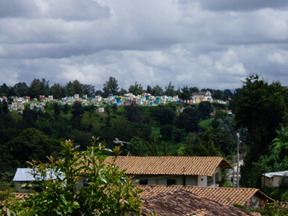 Though isolated, Chichicastenango or "Chichi" is usually a sleepy town with cobblestone streets, which come alive on Thursdays and Sundays when a well known market attracts thousands of Amerindians mostly the K'iche' Maya of the surrounding region, and vendors from all over Guatemala, as well as a large crowd of tourists. Although you can visit Chichi as a day trip from Guatemala City or Antigua, we suggest that you arrive the day before the market and spend the night.
Though isolated, Chichicastenango or "Chichi" is usually a sleepy town with cobblestone streets, which come alive on Thursdays and Sundays when a well known market attracts thousands of Amerindians mostly the K'iche' Maya of the surrounding region, and vendors from all over Guatemala, as well as a large crowd of tourists. Although you can visit Chichi as a day trip from Guatemala City or Antigua, we suggest that you arrive the day before the market and spend the night.
This town in the mountains of Quiche has been, since pre-Hispanic times one of the largest trading centers in the Mayan area. The market starts at the steps of the 460 year old Santo Tomas Church and covers a large area in front of it. Vendors begin setting up portable booths in the main plaza and adjacent streets of "Chichi" the night before and through the early daylight hours. Local artists and artisans sell the products of their crafts as did their ancestors: hand carved masks, colorful and intricate weavings of all sizes from hammocks to tiny pouches, embroided "guilpe", pottery and ceramics and lots of fried chicken, rice and beans, tortillas and fresh fruit including apples, uniquely grown in this cooler region. Children run around selling jewelry and key chains. On the steps of the church of Santo Tomas local shamans combine traditional Mayan religious rites with Catholicism.
The steps of this Catholic church were once leading inside a Mayan temple. 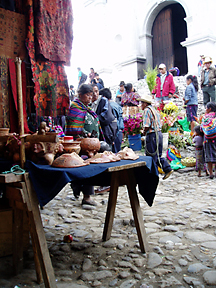 Each of the 18 stairs that lead up to the church stands for one month of the Mayan calendar year. The Mayan calendar has 18 months of 20 days each. Here was discovered the famous Popol Vuh. Chichicastenango has kept much of its traditional culture respected and transmitted from generation to generation. Another excellent place to witness these age old rites is at the Shrine of Pascual Abaj, on the outskirts of town, which honors the Mayan earth god. Surrounded by a cloud of copal (incense) the shaman/priest offers food, drink and cigarettes to ancestral gods to ensure the continued fertility of the earth asking, in their language, for healing and blessings. On the way to the shrine you will pass by the Moreria, a mask and costume factory, for the
Each of the 18 stairs that lead up to the church stands for one month of the Mayan calendar year. The Mayan calendar has 18 months of 20 days each. Here was discovered the famous Popol Vuh. Chichicastenango has kept much of its traditional culture respected and transmitted from generation to generation. Another excellent place to witness these age old rites is at the Shrine of Pascual Abaj, on the outskirts of town, which honors the Mayan earth god. Surrounded by a cloud of copal (incense) the shaman/priest offers food, drink and cigarettes to ancestral gods to ensure the continued fertility of the earth asking, in their language, for healing and blessings. On the way to the shrine you will pass by the Moreria, a mask and costume factory, for the 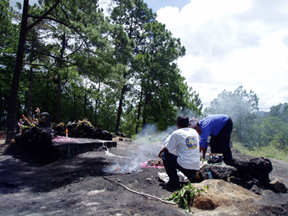 costumes they use for the ceremonies.
costumes they use for the ceremonies.
Undoubtably the most colorfully costumed people in the Americas are the Highland Maya of Guatemala. The design of the women's colorfully embroidered tunics, capes and skirts dates back to pre-colonial days. Certain details of garment and design identify the wearer's group and village, and can also have multiple religious or magical meanings. In Chichi a high percentage of the indigenous people still proudly wear their traditional dress called "traje" which makes market day truly dazzling.
Where to stay in Chichi
Located two blocks from the central plaza, the Hotel Santo Domingo combines authentic Colonial style with modern comforts. Each of the 43 rooms has its own fireplace. Some rooms offer great panoramic views of the surrounding mountains and valleys. The bar and restaurant overlooks a lush courtyard, home of colorful parrots and gurgling fountains. Rates start at $67 per person. email: hst@helgua.com.
Lake Atitlan and Panajachel
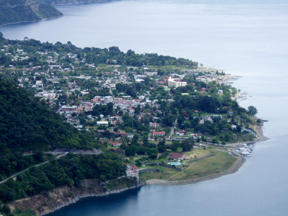 On the way to Lake Atitlan and Panajachel in the Guatemalan highlands, the Peleteria & Botas Atitlan on Calle Real de Pastores is worth a stop if not to buy at least to admire the boots, belts and bags decorated with exotic skins such as manta ray, piton, lizards and cobra. Prices for one of the exotic pairs of boots range from under $100 to several thousands of dollars.
On the way to Lake Atitlan and Panajachel in the Guatemalan highlands, the Peleteria & Botas Atitlan on Calle Real de Pastores is worth a stop if not to buy at least to admire the boots, belts and bags decorated with exotic skins such as manta ray, piton, lizards and cobra. Prices for one of the exotic pairs of boots range from under $100 to several thousands of dollars.
Lake Atitlan itself is a natural wonder of blue, wind-tossed waters set against a backdrop of three 10,000 ft. volcanoes - Toliman, Atitlan and San Pedro - towering on the southern sky. Covered with pine and wide leaf, the volcanoes are refuge to endangered plants and animals. Lining the shores of Lake Atitlan are a dozen Indian villages where life and customs have changed little over the centuries, except in Panajachel.
S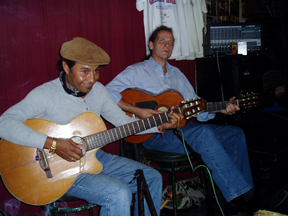 ince the hippie-dippie days of the 1960s, laid-back travelers have flocked here to swim in Lake Atitlan and generally chill out in Panajachel which earns the nickname of Gringotenango ('place of the foreigners'). During the day you can visit the surrounding villages, enjoy the breathtaking views onto the volcanoes that surround the lake or visit Panajachel's busy market street which is a great place to shop for souvenirs. At night music pours o
ince the hippie-dippie days of the 1960s, laid-back travelers have flocked here to swim in Lake Atitlan and generally chill out in Panajachel which earns the nickname of Gringotenango ('place of the foreigners'). During the day you can visit the surrounding villages, enjoy the breathtaking views onto the volcanoes that surround the lake or visit Panajachel's busy market street which is a great place to shop for souvenirs. At night music pours o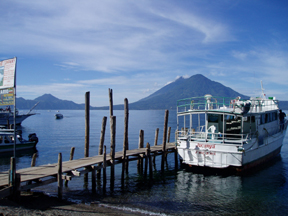 ut into the warm evening air from the multitude of pubs and restaurants.
ut into the warm evening air from the multitude of pubs and restaurants.
A short boat ride away from Panajachel is Santiago, a Tz'utujiil Maya town built on a lava flow on the south shore of Lake Atitlan. The town is a popular day trip for tourists who come to see its ancient church and the unusual costumes of the indigene who come on market day to sell mountains of avocados, hauling the heavy cargo on their backs from the shore of Lake Atitlan up a steep hill leading to the central market place. Locals as well as tourists take the long walk up to the home of the incarnate deity Maximon. This unique, cigar smoking resident conducts business in a small dark room crowded with icons of mixed origins.
Where to stay in Panajachel
The town has numerous affordable hotels and inns and is full of small quality restaurants and bars overlooking the lake and interesting nightspots. Hotel Porta del Lago as its name suggests sits on the shore of Lake Atitlan overlooking the majestic volcanoes. This all-inclusive resort has gorgeous grounds, a superb pool, sauna, gym, a Kids Club, two restaurants and two bars. Prices start at $134 per person, in double. visit www.portahotels.com or email: staying@portahotels.com.
Peten and Tika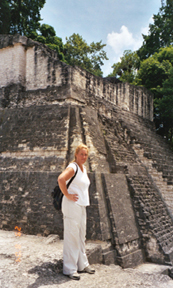 l
l
Leaving the deep blue hues of Lake Atitlan for the turquoise waters of Lake Peten Itza in Northern Guatemala is like stepping into another time and space. Lake Peten is surrounded by a large lowland rainforest. Deep in the thick jungle canopy like stoic sentinels of ancient mysteries the towering pyramids of Tikal remind travelers of the relentless passage of time. A 30 minute flight from Guatemala City, catching an early flight on Taca one can take a quick tour of the Tikal National Park and be back in the capital city by nightfall. Truly such a wonder as Tikal deserves more than just sightseeing. Among the world's travel wonders, Tikal is one of the most spiritually powerful spots on earth.
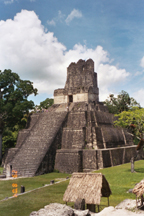 Tikal was once a wealthy metropolis of 100,000 inhabitants and the seat of power for the great Jaguar clan lords. Today, Tikal attracts archaeologists from all around the globe and the wildlife surrounding the ruins makes it a naturalist's dream. Declared a Heritage of Humanity by UNESCO, the Maya metropolis of Tikal was once one of the greatest cities in the world.
Tikal was once a wealthy metropolis of 100,000 inhabitants and the seat of power for the great Jaguar clan lords. Today, Tikal attracts archaeologists from all around the globe and the wildlife surrounding the ruins makes it a naturalist's dream. Declared a Heritage of Humanity by UNESCO, the Maya metropolis of Tikal was once one of the greatest cities in the world.
Strategically located in the lowlands of Guatemala, it boasted over 60,000-70,000 inhabitants at its peak around 750 AD. The five imposing pyramids each exceeding 200 ft. in height were constructed, all within roughly a fifty year span of time. Scarcely less than a century later, and before the Spanish invasion, Tikal, like most of the other Maya city-states, was abandoned to the jungle. Many theorists have advanced elaborate scenarios to explain the abrupt disappearance of the large 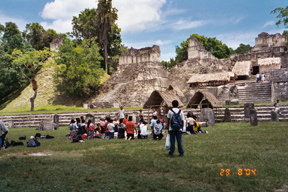 population as well as the eluding prophecy of an "end of the world" (as we know it) on December 21, 2012. Much is available online regarding this prophecy also made by the Hopi people of North America, the Maori elders of New Zealand, and the Indu who predicts with a 24,000 y
population as well as the eluding prophecy of an "end of the world" (as we know it) on December 21, 2012. Much is available online regarding this prophecy also made by the Hopi people of North America, the Maori elders of New Zealand, and the Indu who predicts with a 24,000 y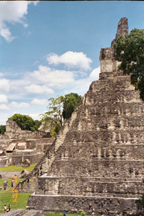 ear cycle the passing from a dark age (Kali Yuga) into an age of light (Satya Yuga). But to find out more about the Mayan prophecy, "The Mayan Factor" by Jose Arguelles is an excellent start as well as “Mayan Astrology & Spiritual Archaeologist” by Aluna Joy Yaxk’in. Just to mention a few!
ear cycle the passing from a dark age (Kali Yuga) into an age of light (Satya Yuga). But to find out more about the Mayan prophecy, "The Mayan Factor" by Jose Arguelles is an excellent start as well as “Mayan Astrology & Spiritual Archaeologist” by Aluna Joy Yaxk’in. Just to mention a few!
Tikal National Park includes more than 3,000 structures extending over six square miles with palaces, temples, ceremonial platforms, ball courts, terraces, plazas, wide avenues amd steam baths. The ancient Mayan began building Tikal around 600 B.C., and for the next 1,500 years the area was an important religious, scientific and political center. Today we can still witness ongoing archaeological sites digging up smaller buildings buried under vegetation and dirt.
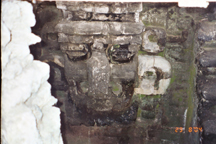 The surrounding forest canopy towering up to 150-180 ft. in height, is home to a rich fauna, from screeching howler monkeys and squawking parrots to white-lipped peccary, deers, toucans, scarlet macaws, parrots and even the seldom jaguar can occasionally be spotted. Along with many vegetation spices (Allspice, Cinnamon) there is also an abundance of tropical flowers and plants with medicinal properties passed on from generation to generation until today. H
The surrounding forest canopy towering up to 150-180 ft. in height, is home to a rich fauna, from screeching howler monkeys and squawking parrots to white-lipped peccary, deers, toucans, scarlet macaws, parrots and even the seldom jaguar can occasionally be spotted. Along with many vegetation spices (Allspice, Cinnamon) there is also an abundance of tropical flowers and plants with medicinal properties passed on from generation to generation until today. H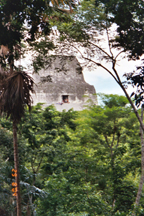 iring a tour guide for this part of the trip is strongly suggested.
iring a tour guide for this part of the trip is strongly suggested.
Where to stay around Tikal.
Camino Real Tikal in San Jose Peten is a tropical five star retreat set in the heart of the Peten jungle. Rates start at $110 per person, including complimentary shuttle to/from the airport This great family resort with swimming pool, kayaking, sunset cruise, parking and car rental is built like a pyramid with many steep stairs dividing the restaurant and bar from the play area and the beach, also lined with Mayan Sauna (for mini sweatlodges).
Over the past four centuries Guatemala has led a double life: the rich Spanish heritage often overshadowing the deep ancestral Mayan culture and history. Today as we open our minds and our hearts to the diversities in our world we begin to honor the many peoples and their cultures allowing all to live side by side in harmony. Guatemala is such a land. A land of promises, long awaited prophecy and much hope for the future.
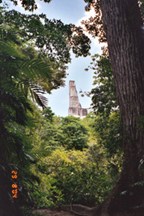 How to get there
How to get there
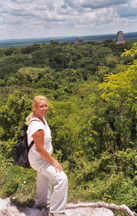 Grupo Taca offers direct flights to Guatemala City from Boston, Chicago, Dallas, Houston, Miami, New York, San Francisco and Washington. For availability and departure, call 800-535-8780 or visit www.grupotaca.com.
Grupo Taca offers direct flights to Guatemala City from Boston, Chicago, Dallas, Houston, Miami, New York, San Francisco and Washington. For availability and departure, call 800-535-8780 or visit www.grupotaca.com.
For additional information on Guatemala call INGUAT at 800-557-0017 or visit: www.espiritumaya.com.gt or email: info@inguat.gov.gt.
From the top of the North Pyramid in Tikal one can see in a distance to the right the top of the other pramid in the center fo the impressive city of Tikal.
Creative Media Graphic Design Services | Healing Art | Fine Art